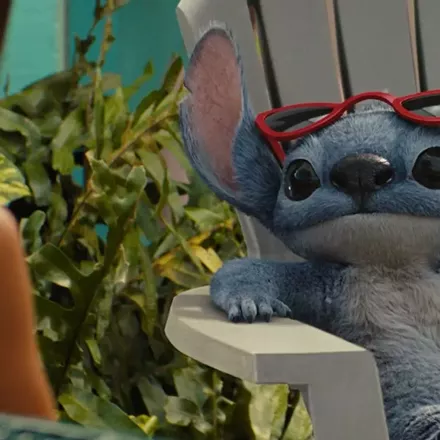A few minutes into the animated film The Triplets of Belleville, you get to see a dancer spinning her breasts in opposite directions. One woman at a recent screening made some indignant sounds when they appeared. At first I was delighted; I was hoping she was as irritated by the animation as I was. But when the nudity ended, I realized she was just mad because she had seen a little bit of "adult content" in an animated film. Oh my! I hope she didn't feel cheated; those breasts alone didn't give the film its PG-13 rating. Maybe she had a better time watching the murder scene, and the sequence in which four elderly ladies dine on barely-cooked frogs. Those were much edgier.
That opening sequence goes a long way toward reminding us that we've learned, where animation is concerned, to settle for an inferior product 90 percent of the time. The dance is shown as part of a television broadcast of a nightclub performance, in which the three ladies of the title sing a few Tinpan Alley tunes and everyone dances around the screen spastically. The whole thing looks like it was made using Flash animation -- the same simplistic system used for Internet animation. Everything jerks frantically between two or three repeated images, trying to milk the most entertainment out of the least amount of work. It's crude, and a wonderful satire of the animated rubbish that fills the video stores and cable networks.
When the television is finally turned off, however, we get to enter the wonderful world of Madame Souza and her grandson, living outside of Paris sometime before World War II. Here, and everywhere else in The Triplets of Belleville, each line is animated with grace and care. Not a lot of motion fills the lives of these two lonely people, but every time it does, it looks fluid and sweeping.
The story of Madame Souza and her grandson is never really explained. He seems to be a war orphan, and the old lady spends the first few minutes of the film trying to find something with which to entertain the chubby, quiet boy. They see the pianist Glenn Gould on television, so she tries a piano. He just goes to his room and sits quietly on the bed. She gets him a puppy. The puppy joins the boy on his bed. Finally Madame Souza discovers her grandson's passion: bicycles. She buys him a tricycle, and after an ecstatic ride around (and around) the yard, the film jumps ahead a few decades.
The dog, named Bruno, has gained weight, and spends his day waiting for his master to return and feed him. Aside from that, his greatest pleasure in life is walking upstairs every hour and barking madly at the train that now passes outside the bedroom window. The grandson, it seems, is training for the Tour de France, aided by his indomitable grandmother. She proudly follows him wherever he bikes, tooting a whistle relentlessly. At the end of the night she massages his oversized muscles with, among other things, an eggbeater and a hand-driven lawnmower. Clearly she loves him. (Although the only real change in her expression is an occasionally lazy eye that drifts starboard before she adjusts it.) So imagine her reaction when she realizes that, in the middle of the anticipated race, her grandson has been kidnapped.
With the unstoppable pace with which she does everything, she takes Bruno after her grandson, eventually winding up in a city called Belleville, in a country that looks like it's based on America. Here Madame Souza meets up with the three singers of the title, and sets out to free her son. There are a few similarities with Finding Nemo, but where that film occasionally reached too far into sentimental territory, The Triplets of Belleville keeps smarmy emotions and clich & eacute;d scenes at a great distance. If anything, the film will disturb as many people as it comforts, with its love of grotesque, near-wordless delivery and button-pushing satire.
And that's great. Why shouldn't animation tweak our expectations? It's a medium, after all, in which anything is possible. These days, however, it takes a rare director to give us anything other than warmed-over re-imaginings of cartoon classics. But Sylvain Chomet, the writer and director of Triplets, has no trouble showing us that it's not the medium of animation that's dying -- it's a sense of adventure and experimentation that's being driven out of the animated film industry.
That's not to say that The Triplets of Belleville is perfect. The dog, whose inner life we have come to know well, is neglected at the film's end. And a computer-generated chase sequence goes on too long, becoming tedious rather than exciting. I realize that not everyone can be as tight or polished as Disney was during its prime. But those films did set the standard for animated motion pictures, and it's disappointing to see a film that moves that tradition forward making such a simple error.
Speaking of Disney -- have you heard that they've pretty much lost their deal with Pixar (the studio that made them Toy Story and Finding Nemo) and have closed most of their own feature film animation studios? It appears that they're getting out of the animation business. That is, unless you consider made-for-cable crap to be animation. And if you do, please do the rest of us a favor and skip The Triplets of Belleville. It's a masterpiece -- a farewell kiss from a dying tradition -- and is best enjoyed by those of us who like that sort of thing. There are plenty of spinning breasts on television for the rest of the world to watch.
















